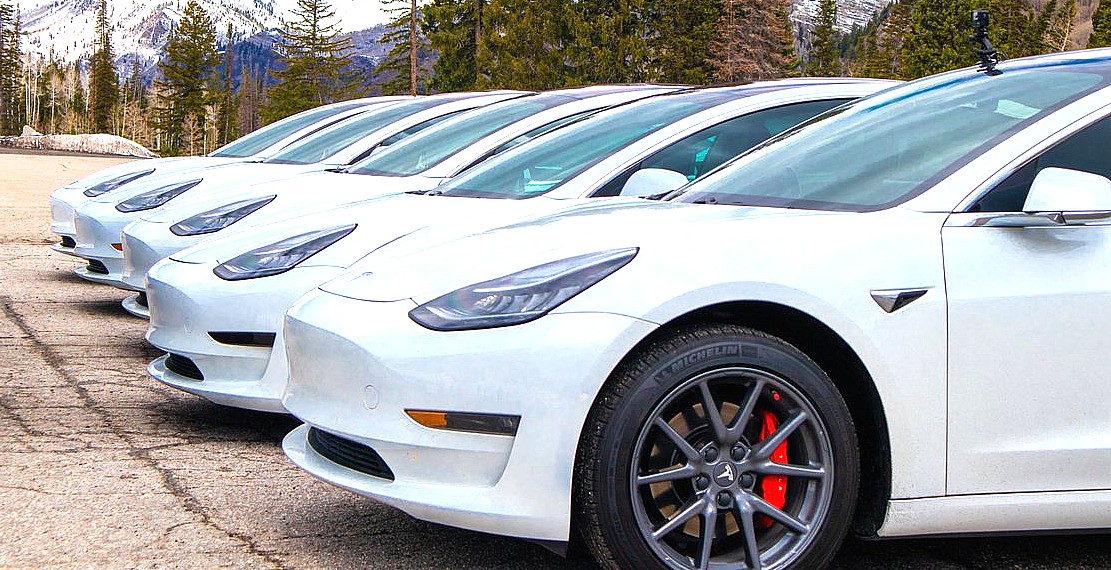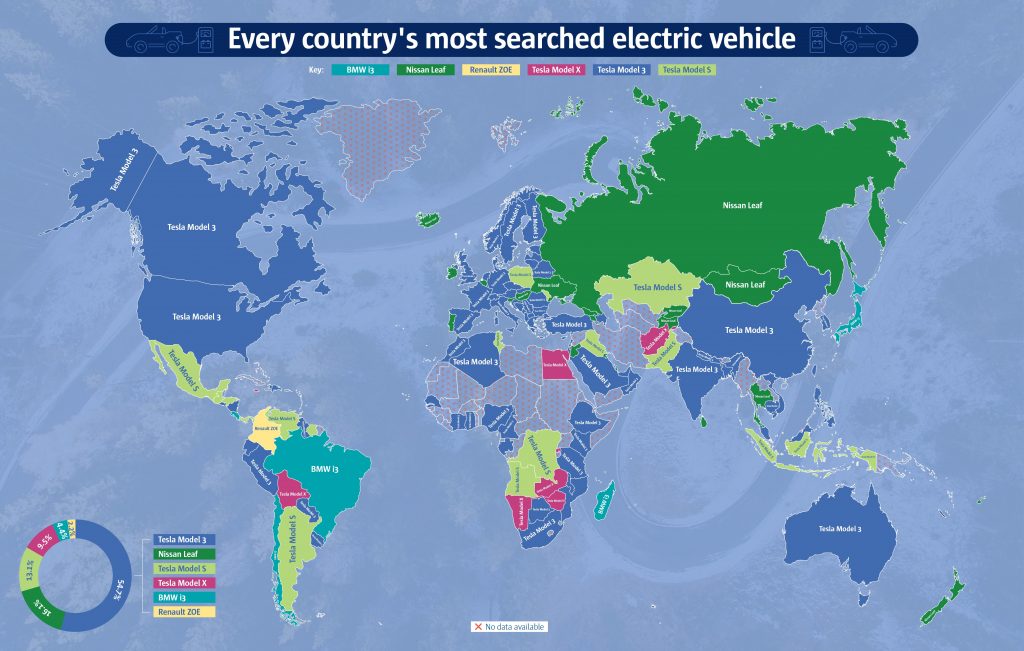

News
Tesla Model 3 tops survey for the world’s most searched-for electric car
A recent study from a Compare the Market, a UK-based price comparison company, has determined that the Tesla Model 3 is currently the world’s most searched-for all-electric vehicle in the world. Following behind the Model 3 was longtime EV veteran Nissan Leaf, as well as Tesla’s two other cars, the Model S and the Model X.
The UK-based firm’s study utilized Google search data to determine the most popular search term for each electric vehicle on the market and compare each car’s popularity across the globe. The survey’s figures are exclusive only to searches of battery-electric cars, as hybrids, plug-in hybrids, and hydrogen vehicles like the Toyota Mirai were not included in the survey.
According to Compare the Market’s results, the Tesla Model 3 is the overwhelming winner worldwide, being the most-searched-for EV in 54.7% of search traffic surveyed. That accounts for more than half of the 136 countries covered in the study. It should be noted that the gap between the Model 3 and the study’s second placer, the Nissan Leaf, was notable as well, with the Japanese-made EV leading in 16.1%, or 22 countries across the globe.

The Tesla Model S and Model X were the study’s 3rd and 4th placers, leading the rankings in 13.1% and 9.5%, taking of the search traffic surveyed. Overall, Tesla’s electric car lineup dominates internet searches for all-electric vehicles in 77.3% of the countries surveyed by the UK-based firm.
Apart from the Nissan Leaf, other non-Tesla vehicles that proved popular in Google searches were the BMW i3 (4.4%), and the Renault Zoe (2.2%). Other premium EVs such as the Jaguar I-PACE, the Audi e-tron, and the Mercedes EQC did not rank in the survey.
The study’s results become quite interesting when they are broken down by country. The Model 3 held a clean lead in a number of the world’s key auto markets, such as the United States, China, most of Europe, and even India, a country that is yet to see its first Tesla store. The Nissan Leaf dominated in Russia, while the Tesla Model S received the most search traffic from Mexico and Argentina. The BMW i3 even proved particularly popular in Brazil.
Interestingly, the study shows that the rankings didn’t necessarily align with the national origins of a particular vehicle. In Japan, for example, it was the BMW i3, a German car, that dominated internet searches. Germany, the home of the BMW i3, displayed strong interest for an American all-electric car, the Tesla Model 3.
Considering the hype and the close news coverage that follows Tesla’s electric car lineup, it is rather unsurprising to see the Model 3 dominating in the UK-based firm’s study. What is particularly notable was that even with the Model 3 taking most of the spotlight, Tesla’s Model S and Model X, which have already been in the market for years, ranked highly in the survey nonetheless. This shows that Tesla has become a brand that is perceived as a premier maker of EVs across the globe, even in areas where it is yet to begin selling its vehicles.
Part of Tesla’s secret sauce for its vehicles’ popularity lies in the company’s strong online presence, which it grows through organic engagement in social media. This was highlighted by a study from competitive intelligence analysis firm BrandTotal, which noted that Tesla, despite investing $0 in paid advertising on social media platforms, is the car company with the strongest social media presence. “Strong brands are able to command high engagement even without a robust digital ad spend. In Tesla’s case, we see their engagement numbers are high compared to other auto brands allocating spend in their digital campaigns,” Alon Leibovich, co-founder & CEO of BrandTotal, said.

Investor's Corner
Tesla stock closes at all-time high on heels of Robotaxi progress

Tesla stock (NASDAQ: TSLA) closed at an all-time high on Tuesday, jumping over 3 percent during the day and finishing at $489.88.
The price beats the previous record close, which was $479.86.
Shares have had a crazy year, dipping more than 40 percent from the start of the year. The stock then started to recover once again around late April, when its price started to climb back up from the low $200 level.
This week, Tesla started to climb toward its highest levels ever, as it was revealed on Sunday that the company was testing driverless Robotaxis in Austin. The spike in value pushed the company’s valuation to $1.63 trillion.
Tesla Robotaxi goes driverless as Musk confirms Safety Monitor removal testing
It is the seventh-most valuable company on the market currently, trailing Nvidia, Apple, Alphabet (Google), Microsoft, Amazon, and Meta.
Shares closed up $14.57 today, up over 3 percent.
The stock has gone through a lot this year, as previously mentioned. Shares tumbled in Q1 due to CEO Elon Musk’s involvement with the Department of Government Efficiency (DOGE), which pulled his attention away from his companies and left a major overhang on their valuations.
However, things started to rebound halfway through the year, and as the government started to phase out the $7,500 tax credit, demand spiked as consumers tried to take advantage of it.
Q3 deliveries were the highest in company history, and Tesla responded to the loss of the tax credit with the launch of the Model 3 and Model Y Standard.
Additionally, analysts have announced high expectations this week for the company on Wall Street as Robotaxi continues to be the focus. With autonomy within Tesla’s sights, things are moving in the direction of Robotaxi being a major catalyst for growth on the Street in the coming year.
Elon Musk
Tesla needs to come through on this one Robotaxi metric, analyst says
“We think the key focus from here will be how fast Tesla can scale driverless operations (including if Tesla’s approach to software/hardware allows it to scale significantly faster than competitors, as the company has argued), and on profitability.”

Tesla needs to come through on this one Robotaxi metric, Mark Delaney of Goldman Sachs says.
Tesla is in the process of rolling out its Robotaxi platform to areas outside of Austin and the California Bay Area. It has plans to launch in five additional cities, including Houston, Dallas, Miami, Las Vegas, and Phoenix.
However, the company’s expansion is not what the focus needs to be, according to Delaney. It’s the speed of deployment.
The analyst said:
“We think the key focus from here will be how fast Tesla can scale driverless operations (including if Tesla’s approach to software/hardware allows it to scale significantly faster than competitors, as the company has argued), and on profitability.”
Profitability will come as the Robotaxi fleet expands. Making that money will be dependent on when Tesla can initiate rides in more areas, giving more customers access to the program.
There are some additional things that the company needs to make happen ahead of the major Robotaxi expansion, one of those things is launching driverless rides in Austin, the first city in which it launched the program.
This week, Tesla started testing driverless Robotaxi rides in Austin, as two different Model Y units were spotted with no occupants, a huge step in the company’s plans for the ride-sharing platform.
Tesla Robotaxi goes driverless as Musk confirms Safety Monitor removal testing
CEO Elon Musk has been hoping to remove Safety Monitors from Robotaxis in Austin for several months, first mentioning the plan to have them out by the end of 2025 in September. He confirmed on Sunday that Tesla had officially removed vehicle occupants and started testing truly unsupervised rides.
Although Safety Monitors in Austin have been sitting in the passenger’s seat, they have still had the ability to override things in case of an emergency. After all, the ultimate goal was safety and avoiding any accidents or injuries.
Goldman Sachs reiterated its ‘Neutral’ rating and its $400 price target. Delaney said, “Tesla is making progress with its autonomous technology,” and recent developments make it evident that this is true.
Investor's Corner
Tesla gets bold Robotaxi prediction from Wall Street firm
Last week, Andrew Percoco took over Tesla analysis for Morgan Stanley from Adam Jonas, who covered the stock for years. Percoco seems to be less optimistic and bullish on Tesla shares, while still being fair and balanced in his analysis.

Tesla (NASDAQ: TSLA) received a bold Robotaxi prediction from Morgan Stanley, which anticipates a dramatic increase in the size of the company’s autonomous ride-hailing suite in the coming years.
Last week, Andrew Percoco took over Tesla analysis for Morgan Stanley from Adam Jonas, who covered the stock for years. Percoco seems to be less optimistic and bullish on Tesla shares, while still being fair and balanced in his analysis.
Percoco dug into the Robotaxi fleet and its expansion in the coming years in his latest note, released on Tuesday. The firm expects Tesla to increase the Robotaxi fleet size to 1,000 vehicles in 2026. However, that’s small-scale compared to what they expect from Tesla in a decade.
Tesla expands Robotaxi app access once again, this time on a global scale
By 2035, Morgan Stanley believes there will be one million Robotaxis on the road across multiple cities, a major jump and a considerable fleet size. We assume this means the fleet of vehicles Tesla will operate internally, and not including passenger-owned vehicles that could be added through software updates.
He also listed three specific catalysts that investors should pay attention to, as these will represent the company being on track to achieve its Robotaxi dreams:
- Opening Robotaxi to the public without a Safety Monitor. Timing is unclear, but it appears that Tesla is getting closer by the day.
- Improvement in safety metrics without the Safety Monitor. Tesla’s ability to improve its safety metrics as it scales miles driven without the Safety Monitor is imperative as it looks to scale in new states and cities in 2026.
- Cybercab start of production, targeted for April 2026. Tesla’s Cybercab is a purpose-built vehicle (no steering wheel or pedals, only two seats) that is expected to be produced through its state-of-the-art unboxed manufacturing process, offering further cost reductions and thus accelerating adoption over time.
Robotaxi stands to be one of Tesla’s most significant revenue contributors, especially as the company plans to continue expanding its ride-hailing service across the world in the coming years.
Its current deployment strategy is controlled and conservative to avoid any drastic and potentially program-ruining incidents.
So far, the program, which is active in Austin and the California Bay Area, has been widely successful.








